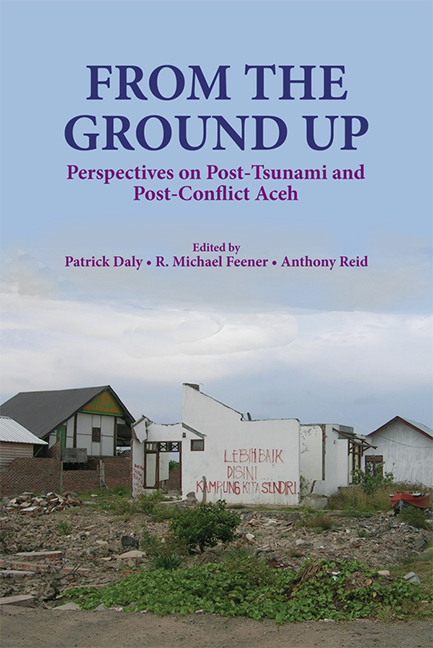Book contents
- Frontmatter
- Contents
- Preface
- List of Figures and Tables
- The Contributors
- Glossary and Abbreviations
- Introduction: Unpacking the Challenges of Post-2004 Aceh
- 1 The Sunda Megathrust: Past, Present and Future
- Part I Reconstruction Efforts
- 2 Disaster Recovery: An International Humanitarian Challenge?
- 3 Linking Relief, Rehabilitation and Development (LRRD) to Social Protection: Lessons from the Early Tsunami Response in Aceh
- 4 Cultural Heritage and Community Recovery in Post-Tsunami Aceh
- 5 Managing Post-Disaster Reconstruction Finance: International Experience in Public Finance Management
- 6 Between Custom and Law: Protecting the Property Rights of Women after the Tsunami in Aceh
- 7 Factors Determining the Movements of Internally Displaced Persons (IDPs) in Aceh
- 8 Aceh's Forests as an Asset for Reconstruction?
- Part II Conflict Resolution
- Index
8 - Aceh's Forests as an Asset for Reconstruction?
from Part I - Reconstruction Efforts
Published online by Cambridge University Press: 21 October 2015
- Frontmatter
- Contents
- Preface
- List of Figures and Tables
- The Contributors
- Glossary and Abbreviations
- Introduction: Unpacking the Challenges of Post-2004 Aceh
- 1 The Sunda Megathrust: Past, Present and Future
- Part I Reconstruction Efforts
- 2 Disaster Recovery: An International Humanitarian Challenge?
- 3 Linking Relief, Rehabilitation and Development (LRRD) to Social Protection: Lessons from the Early Tsunami Response in Aceh
- 4 Cultural Heritage and Community Recovery in Post-Tsunami Aceh
- 5 Managing Post-Disaster Reconstruction Finance: International Experience in Public Finance Management
- 6 Between Custom and Law: Protecting the Property Rights of Women after the Tsunami in Aceh
- 7 Factors Determining the Movements of Internally Displaced Persons (IDPs) in Aceh
- 8 Aceh's Forests as an Asset for Reconstruction?
- Part II Conflict Resolution
- Index
Summary
AN EXCEPTIONALLY RICH FOREST HERITAGE
Recollections from the Seventeenth Century
Forests and forest products have played a central role in Aceh's history; Aceh's very name, according to Denys Lombard (referring to William Marsden), may even be attributable to a plant. During the first decades of the seventeenth century, when Aceh was ruled by Sultan Iskandar Muda and had reached its apex as a regional power, its forest resources played an important economic role. According to Lombard, who quotes the Hikayat Atjéh, the kingdom's prosperity was at least partially linked to its control over resources of the forested interior, among them jungle animals and numerous plants and wood products. Exports of these products continued well after the reign of Iskandar Muda. They included elephants — those same elephants that had played such a crucial role in insuring Aceh's military and even naval power — as well as horses and an apparently even greater number of forest products than before.
Ever since those glorious days in Acehnese history, as settlements and agriculture gradually occupied much of the coastal lowlands, with some expansion even into the interior, Aceh has remained predominantly forested, more so than the rest of Sumatra, at least until very recently.
The Leuser Ecosystem
Mainland Aceh covers some 55,400 km2 (Figure 8.1). The core of that territory, nearly 80 per cent of it, stands over 100 metres above sea level and is characterized by “splayed out ranges and valleys”. That mountainous terrain is predominantly the domain of the forest, a forest that constitutes a treasure trove of biodiversity. In fact, well over half of Nanggroe Aceh Darussalam is occupied by two exceptionally rich and largely mountainous forest domains: the Ulu Masen and Leuser ecosystems (Figure 8.2). The former, which extends over some 7,000 km2, lies entirely within Aceh. Covering nearly 26,000 km2, the much larger Leuser Ecosystem overlaps into the province of North Sumatra, which holds approximately one-eighth of it.
- Type
- Chapter
- Information
- From the Ground UpPerspectives on Post-Tsunami and Post-Conflict Aceh, pp. 156 - 176Publisher: ISEAS–Yusof Ishak InstitutePrint publication year: 2012

